38/2009. (VIII. 31.) IRM rendelet
a Tanács fizetésképtelenségi eljárásokról szóló 1346/2000/EK rendeletének 40. cikkében előírt értesítés formai és tartalmi kellékeiről
Veszélyhelyzeti normák
Egyes veszélyhelyzeti III./járványügyi normák:[1]
2021. évi XCIX. törvény (különösen: 3. §)
112/2021. (III. 6.) Korm. rendelet (különösen: 1. §)
Egyes veszélyhelyzeti I. normák:[2]
74/2020. (III. 31.) Korm. rendelet (különösen: 1. §, 97. §)
A csődeljárásról és felszámolási eljárásról szóló 1991. évi XLIX. törvény 85. §-ának (6) bekezdésében foglalt felhatalmazás alapján, az igazságügyi és rendészeti miniszter feladat- és hatásköréről szóló 164/2006. (VII. 28.) Korm. rendelet 1. §-ának h) pontjában meghatározott feladatkörömben eljárva a következőket rendelem el:
1. § A csődeljárásban az e rendelet 1. számú melléklete, a felszámolási eljárásban pedig az e rendelet 2. számú melléklete szerinti formanyomtatványt kell alkalmazni a hitelezők értesítésére.
2. § (1) E rendelet 2009. szeptember 1-jén lép hatályba, rendelkezéseit az ezt követően kezdeményezett csődeljárásokra és felszámolási eljárásokra kell alkalmazni.
(2)[3]
(3) Ez a rendelet a fizetésképtelenségi eljárásokról szóló, 2000. május 29-i 1346/2000/EK tanácsi rendelet 40. cikkének végrehajtásához szükséges rendelkezéseket állapítja meg.
Dr. Draskovics Tibor s. k.,
igazságügyi és rendészeti miniszter
1. melléklet a 38/2009. (VIII. 31.) IRM rendelethez[4]
A. Felhívás követelés bejelentésére a csődeljárásban
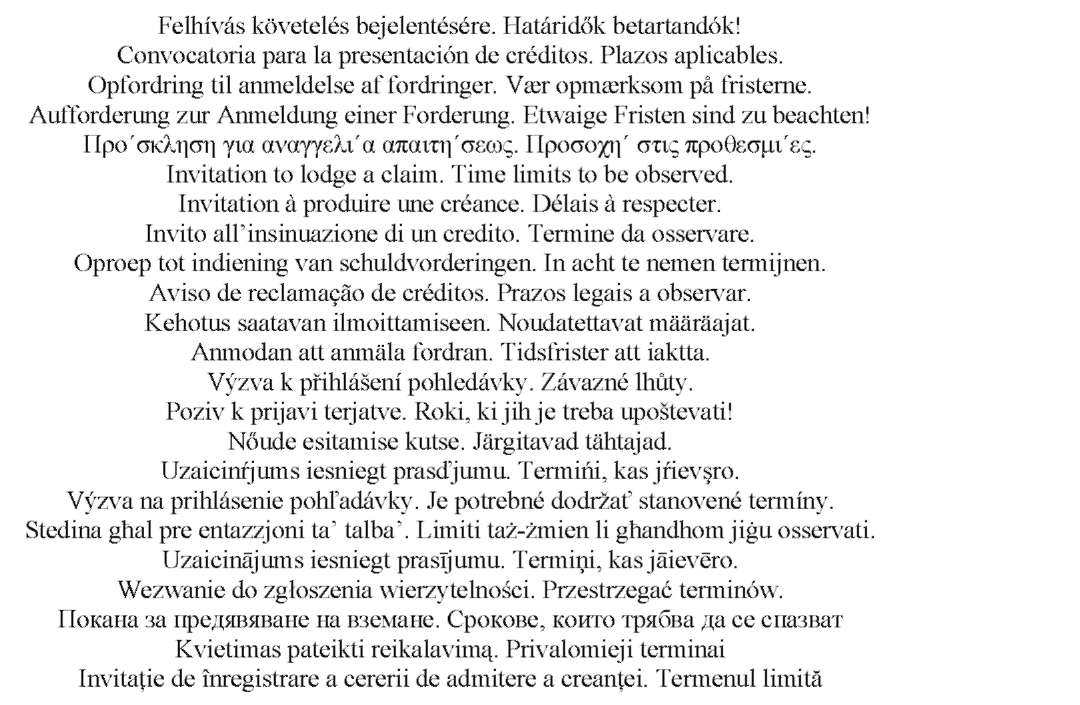
| 1. A csődeljárást elrendelő bíróság: |
| 2. A csődeljárást elrendelő bírósági határozat ügyszáma: |
| 3. A csődeljárást elrendelő bírósági határozat meghozatalának időpontja: |
| 4. Az adós neve, székhelye és címe: |
| 5. A vagyonfelügyelő neve, székhelye és címe: |
| 6. A eljárást elrendelő bírósági határozat Cégközlönyben való közzétételének napja, amely a |
| fizetési haladék kezdete |
| 7. A vagyonfelügyelő pénzügyi intézménynél vezetett díjelszámolási számlájának száma: |
| 8. Az ideiglenes fizetési haladék (Cstv. 9. § (1) bekezdés) kezdete: |
I. Az 1. pont szerinti bíróság a 2. pont szerinti ügyszám alatt, az adós kérelmére a 3. pont szerinti időpontban hozott határozatában a 4. pont szerinti adós ellen csődeljárást indított. Ez az eljárás az 1346/2000/EK tanácsi rendelet 2. cikk a) pontja szerinti fizetésképtelenségi eljárás. A 3. pont szerinti időpont a fizetésképtelenségi eljárás megindításának időpontja (1346/2000/EK tanácsi rendelet, 2. cikk f) pont). A bíróság határozatában kijelölte az 5. pont szerinti vagyonfelügyelőt a csődeljárásról és felszámolási eljárásról szóló 1991. évi XLIX. törvény (a továbbiakban: Cstv.) II. fejezete szerint lefolytatandó eljárásban a törvényben meghatározott feladatok ellátására.
A fizetési haladék jogkövetkezményeit a Cstv. 10. § és 11. §-a tartalmazza.
Ezen értesítési kötelezettség alapja az 1346/2000/EK tanácsi rendelet 40. cikke, amely szerint a fizetésképtelenségi eljárás megindításának helyétől eltérő tagállamban szokásos tartózkodási hellyel, állandó lakóhellyel, székhellyel rendelkező, ismert hitelezőket tájékoztatni kell a fizetésképtelenségi eljárás megindulásáról.
Az 1346/2000/EK tanácsi rendelet 39. cikke szerint bármely hitelezőnek - ideértve a tagállamok adóhatóságait és társadalombiztosítási hatóságait (intézményeit) -, akinek szokásos tartózkodási helye, lakóhelye vagy székhelye más tagállamban van, mint az eljárás megindításának helye szerinti állam, jogában áll írásban bejelenteni követeléseit a fizetésképtelenségi eljárásban.
II.A hitelezői követelések bejelentésére előírt határidő, a hitelezői követelések bejelentésével szembeni formai és tartalmi követelmények
A hitelezőknek be kell jelenteniük a követeléseikre vonatkozó adatokat, és csatolniuk kell az azokat megalapozó okiratokat is (Cstv. 12. §).
A csődeljárásban a hitelezői követeléseket a csődeljárás elrendeléséről szóló végzés közzétételétől számított 30 napon belül - a közzétételt követően keletkező követeléseiket pedig 8 munkanapon belül - be kell jelenteniük az adósnak és az 5. pontban megjelölt vagyonfelügyelőnek (Cstv. 12. §).
A követelést bejelentő iratot a hitelezőnek "KÖVETELÉSBEJELENTÉS" felirattal ellátva 2 példányban magyar nyelven, vagy a saját szokásos tartózkodási helye, lakóhelye, székhelye szerinti tagállam hivatalos nyelvén, vagy hivatalos nyelvei valamelyikén, de magyar nyelvű hivatalos fordítást is csatolva kell benyújtania. A magyar nyelvű "KÖVETELÉSBEJELENTÉS" feliratot az iratnak minden esetben tartalmaznia kell (1346/2000/EK tanácsi rendelet, 42. cikk (2) bekezdés).
A követelést bejelentő iratban a hitelezőnek meg kell jelölnie követelése jellegét, keletkezésének időpontját, összegét, továbbá azt, hogy követelése tekintetében elsőbbségre tart-e igényt, követelését zálogjog, más dologi biztosíték vagy tulajdonjog-fenntartás biztosítja-e és zálogjoga, más dologi biztosítéka vagy fenntartott tulajdonjoga milyen vagyontárgyakra terjed ki. A követelést bejelentő irathoz a hitelezőnek csatolnia kell a követelést megalapozó iratok másolatát (1346/2000/EK tanácsi rendelet 41. cikk).
A hitelezőnek a Magyar Nemzeti Banknak a Cégközlönyben való közzététel időpontja szerinti árfolyama alapján forintban is meg kell határoznia követelése összegét.
A követelés nyilvántartásba vételéért díjat kell fizetni a 7. pontban megjelölt számlaszámra - a követelés forintban átszámított összegének 1%-át, de legalább 5000 forintot és legfeljebb 100 000 forintot - amely a vagyonfelügyelő igazolt költségeinek és díjának lesz a fedezete. (Cstv. 10. § és 12. §). Nem kell bejelenteni a Cstv. 11. § (1) bekezdése szerinti követeléseket, azaz azokat, amelyekre nem terjed ki a csődeljárás alatti fizetési haladék (moratórium).
III.A hitelezői követelések bejelentésére előírt határidő elmulasztásának jogkövetkezménye
A bejelentési határidő elmulasztása esetén a hitelező követelését a vagyonfelügyelő nem veszi nyilvántartásba, így nem tud szavazati joggal élni sem a hitelezői választmányban, sem pedig a csődeljárás során, így nem tud részt venni az adósságrendezési célú csődegyezség megkötésében sem (Cstv. 5/A. §, 12. §, 14. §, 18. §, 20. §), annak hatálya nem terjed ki rá. Az elmulasztott határidő miatt ez a hitelező a csődeljárásban és a csődegyezség alatt az adós ellen nem érvényesítheti követelését, továbbá csak a más által indított felszámolási eljárásban jelentheti be a még el nem évült követelését. Ez utóbbi esetben azonban nem érvényesítheti a késedelmi kamatra, késedelmi pótlékra, pótlék és bírság jellegű követelését a felszámolási eljárásban.
IV.A hitelezői követelések bejelentésével szembeni formai és tartalmi követelmények
A hitelezőknek be kell jelenteniük a követeléseikre vonatkozó adatokat és csatolniuk kell az azokat megalapozó okiratokat is (Cstv. 12. §).
V.A bejelentett hitelezői követelés nyilvántartásba vétele
A követeléseket a vagyonfelügyelő az adós bevonásával veszi nyilvántartásba és sorolja be, melynek eredményéről a hitelezőket értesíti. Erre az eljárásra a Cstv. 12. és 14. §-a irányadó.
A külföldi székhelyű, illetőleg külföldi lakóhellyel rendelkező hitelezőknek kézbesítési megbízottat kell igénybe venniük
VI.Kormányrendeletben stratégiailag kiemeltként minősített vállalkozásokra a Cstv. IV. fejezete sajátos szabályokat tartalmaz.
B. Invitation to Lodge a Claim in Bankruptcy Proceedings

| 1. Court ordering the bankruptcy proceedings: |
| 2. Case number of Court Decision opening the bankruptcy proceedings: 3. Date of the Court Decision opening the bankruptcy proceedings: 4. Debtor's name, registered office and address: |
| 5. Bankruptcy Trustee's name, registered office and address: |
| 6. Date of the publication of the Court Decision opening the proceedings in the official journal |
| "Cégközlöny", as the beginning of the stay of payment: 7. Number of Bankruptcy Trustee's fee settlement account at a financial institution: |
| 8. Beginning of temporary stay of payment (Section 9 (1) of the Act on Bankruptcy Proceedings): |
I. The Court under point 1 opened bankruptcy proceedings against the Debtor under point 4 in its Decision taken on the date set out in point 3 under case number referred to in point 2, at the Debtor's request. These proceedings are insolvency proceedings within the meaning of Article 2 a) of Council Regulation (EC) 1346/2000. The date under point 3 is the date of the opening of the insolvency proceedings (Article 2 f) of Council Regulation (EC) 1346/2000). In its Decision the Court appointed the Bankruptcy Trustee under point 5 to carry out the duties provided for by law in the proceedings to be conducted in accordance with Chapter II of Act XLIX of 1991 on Bankruptcy Proceedings and Liquidation Proceedings (hereinafter the Bankruptcy Act).
The legal consequences of the stay of payment are provided in Sections 10 and 11 of the Bankruptcy Act.
The duty to provide information is provided for in Article 40 of Council Regulation (EC) 1346/2000 according to which the known Creditors who have their habitual residences, domiciles or registered offices in another Member State than where the insolvency proceedings are opened shall be informed about the openingof the insolvency proceedings.
Article 39 of Council Regulation (EC) 1346/2000 prescribes that any Creditor who has his habitual residence, domicile or registered office in a Member State other than the State of the opening of proceedings, including the tax authorities and social security authorities of Member States, shall have the right to lodge claims in the insolvency proceedings in writing.
II.Time limit, form and content of lodging Creditor's claims
Creditors shall report the data relevant to their claims and attach the supporting documents (Section 12 of Bankruptcy Act).
In the bankruptcy proceedings, the Creditor shall report his claims to the Debtor and to the Bankruptcy Trustee under point 5 within 30 days following the publication of the Decision opening the bankruptcy proceedings; in the case of claims arising after the publication of the said Decision, the time limit for reporting these claims shall be limited to 8 working days (Section 12 of Bankruptcy Act).
The Creditor shall submit the document on lodging his claim with the heading "LODGEMENT OF CLAIM" in 2 copies in Hungarian language or in the official language or one of the official languages of the State of his habitual residence, domicile or registered office; in the latter case he will be required to provide an official translation in Hungarian language. The document shall in every case bear the Hungarian language heading "KÖVETELÉSBEJELENTÉS" (i.e. "LODGEMENT OF CLAIM") (Article 42 (2) of Council Regulation (EC) 1346/2000).
In the document on lodging the claim the Creditor shall indicate the nature of the claim, the date on which it arose and its amount, as well as whether he alleges preference in respect of his claim and whether his claim is secured by a lien, another security in rem or a reservation of title, and what assets are covered by the lien, the other security in rem or the title reserved. The Creditor shall attach the copy of the documents that underlie the claim to the document on lodging his claim (Article 41 of Council Regulation (EC) 1346/2000).
The Creditor shall specify the amount of his claim in Hungarian Forint (HUF) as well, at the exchange rate quoted by the National Bank of Hungary applicable at the time of publication in the official journal Cégközlöny.
A fee - amounting to 1% of the value of the claim determined in HUF but HUF 5 000 at least and HUF 100 000 at most - shall be payable to the account number under point 7 for the registration of the claim, to cover the Bankruptcy Trustee's substantiated costs and fees (Sections 10 and 12 of Bankruptcy Act). Claims under Section 11 (1) of the Bankruptcy Act - i.e. the ones not covered by the stay of payment during bankruptcy proceedings - have not to be lodged.
III.Legal consequences of missing the time limit for lodging Creditor's claims
If the time limit for lodging the claim is not observed, the Bankruptcy Trustee shall not register the Creditor's claim, which means that he shall not exercise his right to vote in the creditors' committee nor during the bankruptcy proceedings and shall therefore not take part in the conclusion of an arrengement with creditors to settle the debt (Sections 5/A., 12, 14, 18 and 20 of Bankruptcy Act) and shall not be covered by that arrangement. Because of failing to meet the time limit, the Creditor may not enforce his claim during the bankruptcy proceedings and under the arrengement with creditors, and the Creditor may only logde his claims during a liquidation proceeding launched by another creditor. In this latter case, during the liquidation proceeding, the Creditor may not enforce his claim of default interest, default penalty and other penalty claims.
IV.Form and content of lodging Creditor's claims
Creditors shall report the data relevant to their claims and attach the supporting documents (Section 12 of Bankruptcy Act).
V.Registration of the Creditor's lodged claim
The Bankruptcy Trustee shall register and classify the claims with the Debtor's involvement and shall notify the Creditors about the outcome thereof. Sections 12 and 14 of the Bankruptcy Act apply to these proceedings.
Creditors having their domicile or registered office outside of Hungary shall appoint a representative ad litem.
VI.Chapter IV of the of the Bankruptcy Act provides for specific rules applicable to undertakings declared by a Government Decree to have high strategic priority.

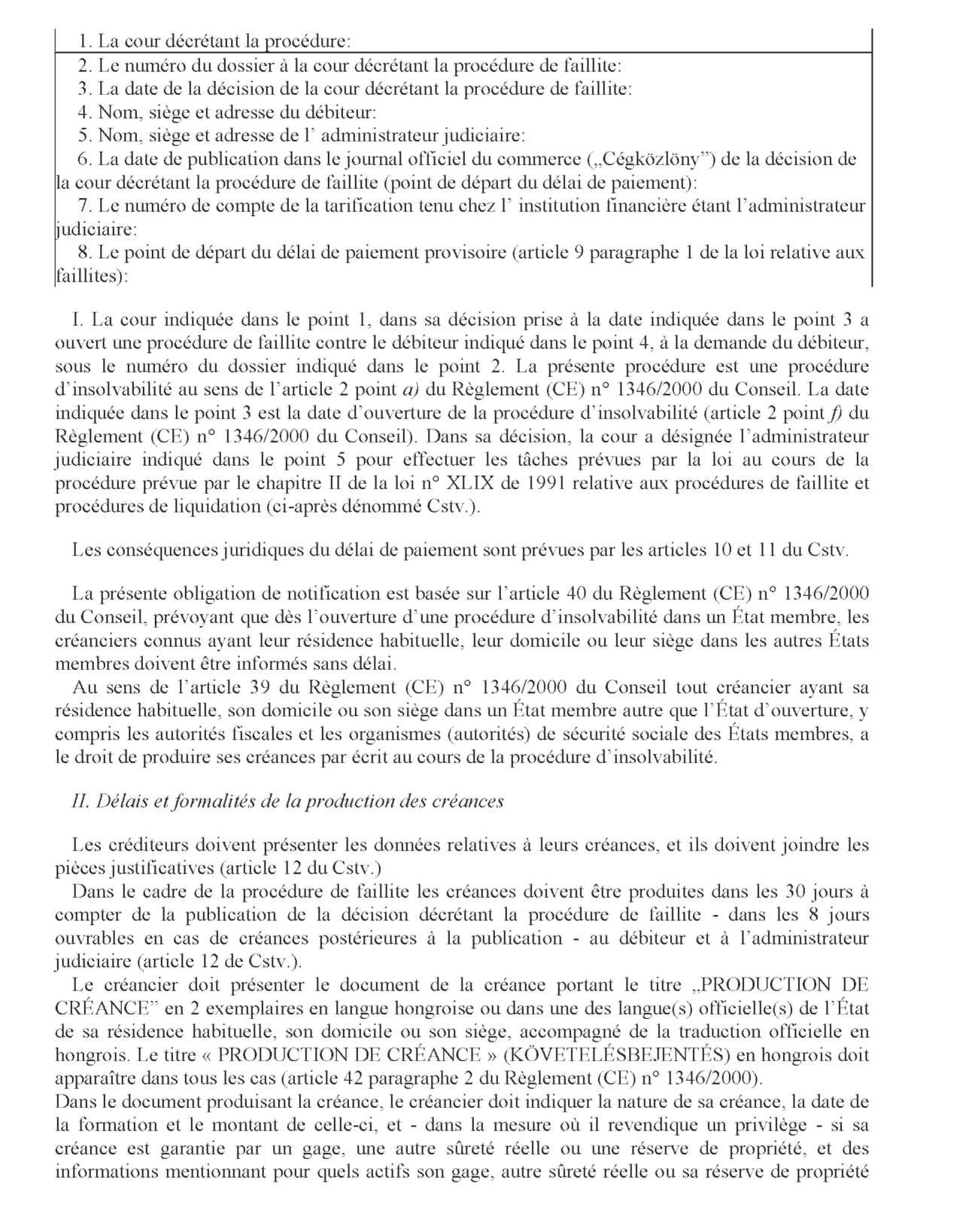
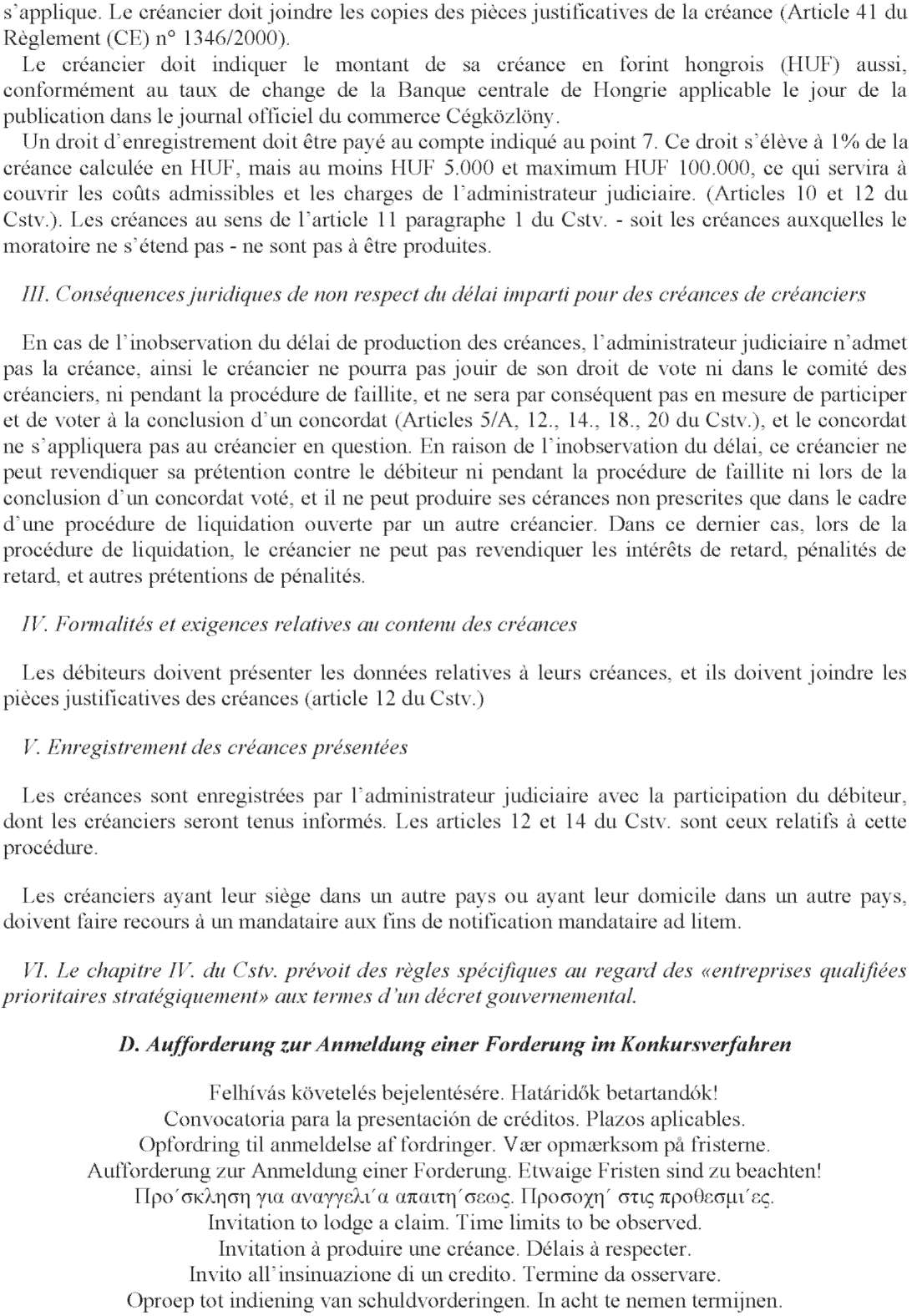
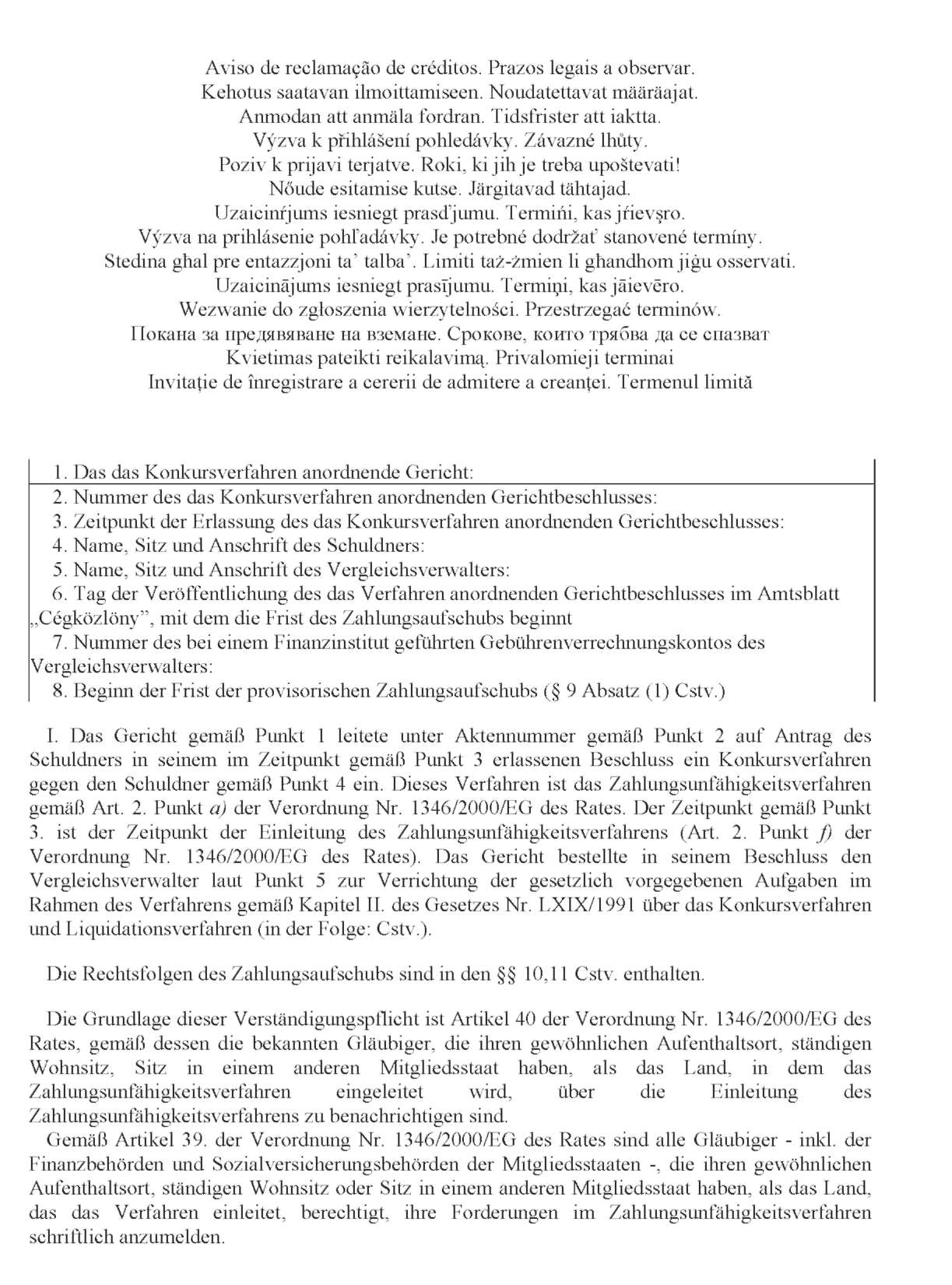
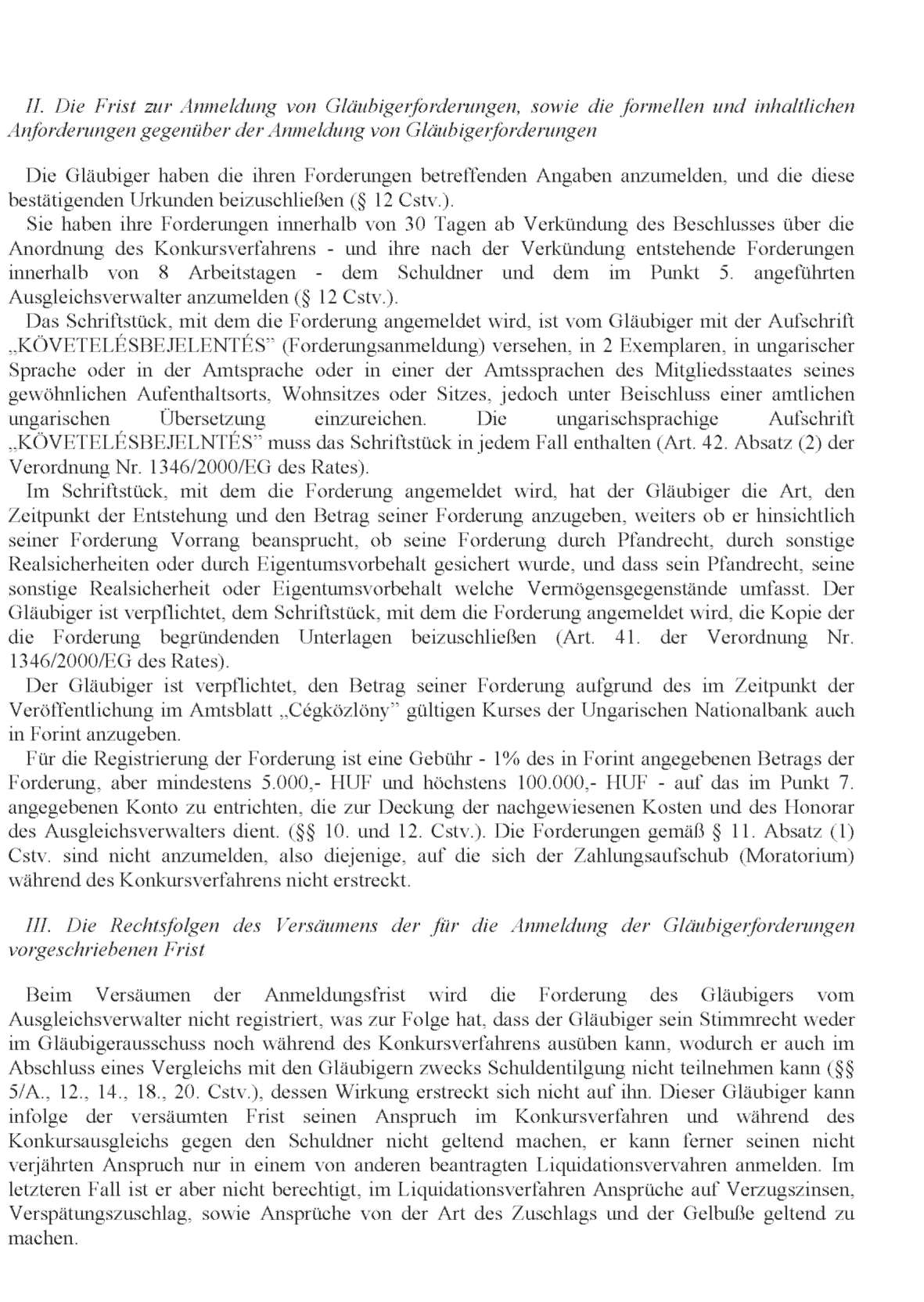
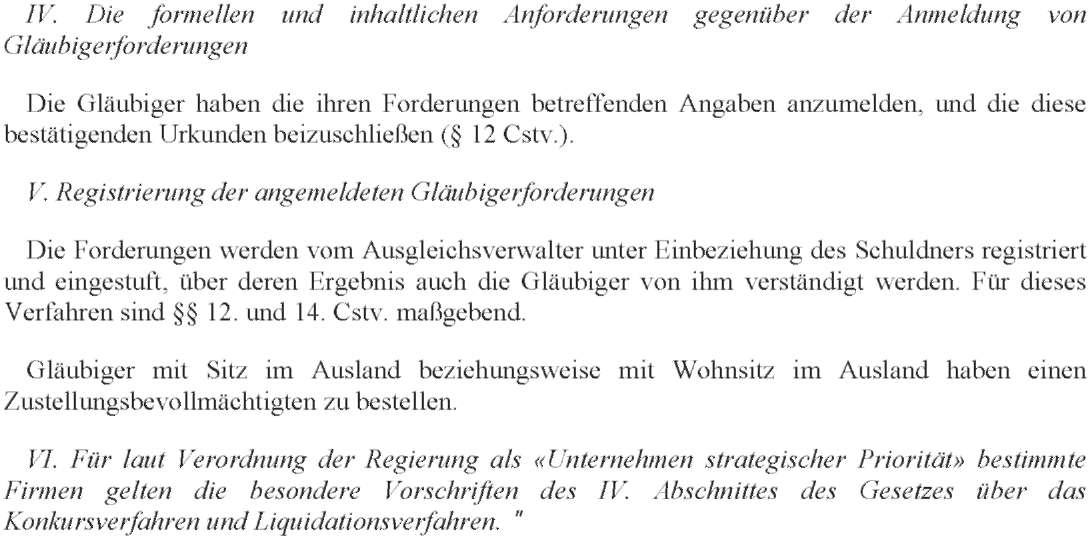
2. melléklet a 38/2009. (VIII. 31.) IRM rendelethez[5]
A. Felhívás követelés bejelentésére a felszámolási eljárásban
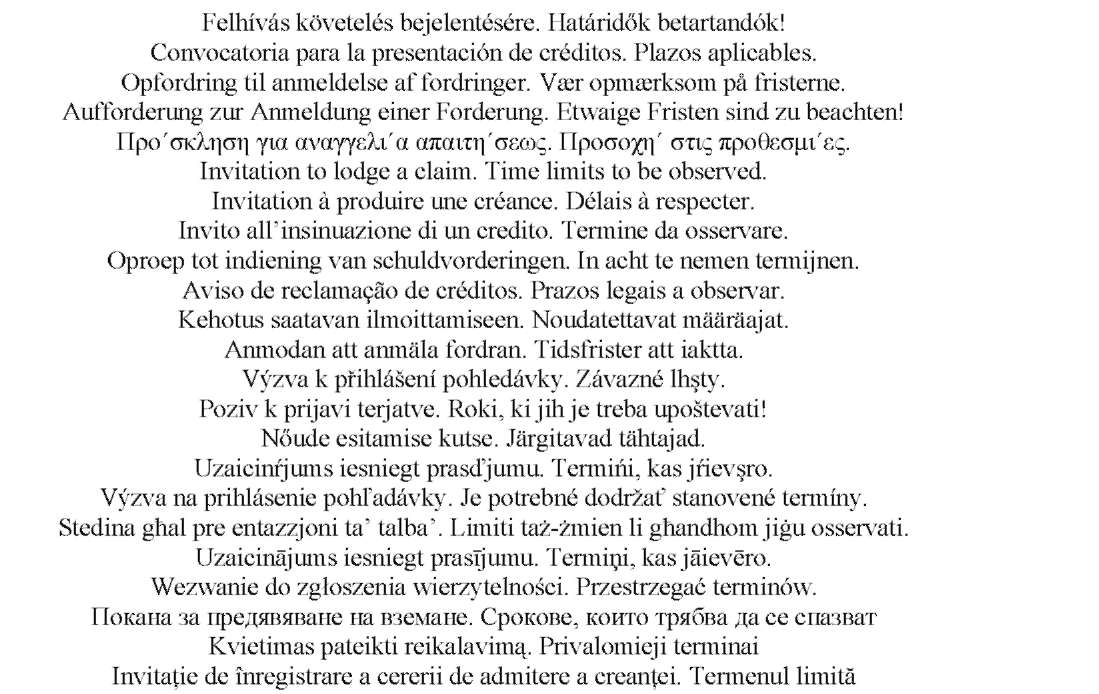
| 1. A felszámolási eljárást lefolytató bíróság: |
| 2. A felszámolási eljárást elrendelő bírósági határozat száma: |
| 3. A felszámolási eljárást elrendelő bírósági határozat meghozatalának időpontja: |
| 4. Az adós neve, székhelye és címe: |
| 5. Az eljárás típusa: főeljárás/területi eljárás |
| 6. A felszámoló neve, székhelye és címe: |
| 7. A felszámolást elrendelő bírósági határozat Cégközlönyben való közzétételének napja: |
| 8. A felszámolási eljárást lefolytató bíróság Gazdasági Hivatala díjfedezeti számlájának száma: |
I. Az 1. pont szerinti bíróság a 2. pont szerinti ügyszám alatt, a 3. pont szerinti időpontban hozott határozatában a 4. pont szerinti adós ellen felszámolási eljárást indított. E felszámolási eljárás az 1346/2000/EK tanácsi rendelet szerinti eljárás (5. pont). A 7. pont szerinti időpont a fizetésképtelenségi eljárás megindításának időpontja (1346/2000/EK tanácsi rendelet 2. cikk f) pont). A bíróság határozatában kijelölte a 6. pont szerinti felszámolót. A 7. pont szerinti időponttól kezdődően az adós vagyonával kapcsolatos jognyilatkozatot csak a felszámoló tehet.
Ezen értesítés alapja az 1346/2000/EK tanácsi rendelet 40. cikke, amely szerint a fizetésképtelenségi eljárás megindításának helyétől eltérő tagállamban szokásos tartózkodási hellyel, állandó lakóhellyel, székhellyel rendelkező, ismert hitelezőket tájékoztatni kell a fizetésképtelenségi eljárás megindulásáról.
Az 1346/2000/EK tanácsi rendelet 39. cikke szerint bármely hitelezőnek - ideértve a tagállamok adóhatóságait és társadalombiztosítási intézményeit (hatóságait) is -, akinek szokásos tartózkodási helye, lakóhelye vagy székhelye más tagállamban van, mint az eljárás megindításának helye szerinti állam, jogában áll írásban bejelenteni követeléseit a fizetésképtelenségi eljárásban.
II.A hitelezői követelések bejelentésére előírt határidő
A csődeljárásról és a felszámolási eljárásról szóló 1991. évi XLIX. törvény (a továbbiakban: Cstv.) 28. §-ának (1) bekezdése alapján a bíróság elrendelte a határozat Cégközlönyben való közzétételét. A bírósági határozat közzététele a 7. pont szerinti időpontban megtörtént. Az ettől az időponttól számított 40 napos határidőn belül kell a követelést a hitelezőknek a felszámoló (6. pont) számára írásban bejelenteni [Cstv. 28. § (2) bekezdés f) pont]. A követelést bejelentő irat könyvelt (ajánlott vagy tértivevényes postai különszolgáltatással) küldeményként adható postára, legkésőbb a határidő utolsó napján.
A felszámolási eljárás alatt keletkezett hitelezői igényt (ha felszámolási költségnek nem minősül, és a felszámolási zárómérleget még nem nyújtották be) az esedékessé válását követő 40 napon belül kell bejelenteni.
A követelés bejelentésének kötelezettsége a dologi biztosítékkal rendelkező hitelezőkre is kiterjed.
A Cstv. 36. §-ának (1) bekezdése szerint a felszámolás során csak olyan követelés számítható be, amelyet a felszámoló elismertként nyilvántartásba vett, és amelynek tekintetében a felszámolás kezdő időpontját - vagy ha a követelés később keletkezett, a keletkezését - követően nem került sor engedményezésre. Nem számíthatja be az adóssal szembeni követelését az adós gazdálkodó szervezet vezető tisztségviselője, vezető állású munkavállalója vagy azok közeli hozzátartozója, illetve élettársa, valamint az adós többségi befolyása alatt álló gazdálkodó szervezet, továbbá az adós gazdálkodó szervezet többségi befolyással rendelkező tagja (egyszemélyes társaság esetén a tag, külföldi székhelyű vállalkozás magyarországi fióktelepe esetén a külföldi székhelyű vállalkozás).
III.A hitelezői követelések bejelentésére előírt határidő elmulasztásának jogkövetkezménye
Az adóssal szemben fennálló olyan követeléseket, amelyeket a felszámolás közzétételétől számított 40 napon túl, de 180 napon belül jelentettek be, a felszámoló nyilvántartásba veszi, de az ilyen hitelezői követelés csak abban az esetben elégíthető ki, ha - az egyezségkötést kivéve - a határidőben bejelentett követelések (a Cstv. 57. §-ának (1) bekezdésében felsorolt tartozások) kiegyenlítése után van rá vagyoni fedezet. A Cégközlönyben való közzétételtől számított 180 napos határidő elmulasztása jogvesztéssel jár (Cstv. 37. § (1)-(3) bekezdés).
IV.A hitelezői követelések bejelentésével szembeni formai és tartalmi követelmények
A követelést bejelentő iratot a hitelezőnek "KÖVETELÉSBEJELENTÉS" felirattal ellátva 2 példányban magyar nyelven, vagy a saját szokásos tartózkodási helye, lakóhelye, székhelye szerinti tagállam hivatalos nyelvén, vagy hivatalos nyelvei valamelyikén, de magyar nyelvű hivatalos fordítást is csatolva kell benyújtania. A magyar nyelvű "KÖVETELÉSBEJELENTÉS" feliratot az iratnak minden esetben tartalmaznia kell (1346/2000/EK tanácsi rendelet 42. cikk (2) bekezdés).
A követelést bejelentő iratban a hitelezőnek meg kell jelölnie követelése jellegét, keletkezésének időpontját, összegét, továbbá azt, hogy követelése tekintetében elsőbbségre tart-e igényt, követelését zálogjog, más dologi biztosíték vagy tulajdonjog-fenntartás biztosítja-e és zálogjoga, más dologi biztosítéka vagy fenntartott tulajdonjoga milyen vagyontárgyakra terjed ki. A követelést bejelentő irathoz a hitelezőnek csatolnia kell a követelést megalapozó iratok másolatát (1346/2000/EK tanácsi rendelet, 41. cikk).
A hitelezőnek a Magyar Nemzeti Banknak a Cégközlönyben való közzététel időpontja szerinti árfolyama alapján forintban is meg kell határoznia követelése összegét.
A Cstv. 36. §-ának (2) bekezdése szerint a Cégközlönyben való közzététel időpontját megelőzően létrejött, pozíciólezáró nettósításra irányuló megállapodás esetén a hitelezőnek a nettó követelést kell a felszámolónak bejelentenie, illetve a felszámoló a nettó követelést érvényesíti. A pozíciólezáró nettósításon alapuló nettó követelés kiszámítása során irányadó értéknap a felek megállapodásában meghatározott, de minden esetben a hitelezői igények bejelentésére nyitva álló határidő lejártát megelőző időpont.
A hitelezői igény nyilvántartásba vételének feltétele továbbá, hogy a hitelező - követelésének a felszámolóhoz való bejelentésén felül - az adóssal szemben érvényesíteni kívánt követelés tőkeösszegének 1%-át, de legalább 5000, legfeljebb azonban 200 000 Ft-ot átutaljon a felszámolási eljárást elrendelő bíróság (1. pont) Gazdasági Hivatalának díjfedezeti számlájára (8. pont), megjelölve az adóst (4. pont) és a felszámolási eljárást elrendelő bírósági határozat ügyszámát (2. pont) és ezt a felszámolónak igazolja. Ha a felszámolási eljárást közvetlenül csődeljárás előzte meg, és a hitelező a követelését ott bejelentette, és kifizette a nyilvántartásba-vételi díjat is, a felszámolási eljárásban a követelést nem kell ismét bejelentenie, azonban a felszámoló felhívására meg kell fizetnie a díjkülönbözetet.
Ha a hitelező ezt az összeget nem utalja át a Gazdasági Hivatal fent megjelölt számlájára, s ezt nem igazolja a felszámoló részére, a felszámoló nem veszi hitelezőként nyilvántartásba. A nyilvántartásba vételi díj fizetésének kötelezettsége nem vonatkozik azokra a hitelezőkre, akiknek a követelése a Cstv. 57. § (2) bekezdése alapján felszámolási költségnek minősül vagy a gazdálkodó szervezetet terhelő tartásdíj, életjáradék, kártérítési járadék, bányászati keresetkiegészítés, továbbá a mezőgazdasági szövetkezet tagja részére a háztáji föld vagy termény helyett adott pénzbeli juttatás, amely a jogosultat élete végéig megilleti (Cstv. 46. § (7) bekezdés).
V. A bejelentett hitelezői követelés nyilvántartásba vétele
A Cstv. 46. §-ának (6) bekezdése szerint a felszámoló a határidőben bejelentett követeléseket a bejelentési határnapot követő 45 napon belül köteles felülvizsgálni, az érdekeltekkel egyeztetni. Ha a felszámoló a hitelezői követelést akár a jogalap, akár az összegszerűség vonatkozásában vitatja, ezt közli a hitelezővel. Ha a hitelező a felszámoló közlésében foglaltakkal nem ért egyet, és a felszámoló és a hitelező közötti egyeztetés sikertelen, a felszámoló köteles a vitathatónak minősített igényeket elbírálás végett 15 napon belül a felszámolást elrendelő bíróságnak megküldeni. Ha a hitelező nem ért egyet követelésének a felszámoló általi besorolásával, a Cstv. 51. §-ának (1) bekezdése szerint a tudomásszerzéstől számított 8 napon belül kifogással élhet a felszámolási eljárást elrendelő bíróságnál (1. pont). A felszámoló nem minősítheti vitathatónak azt a hitelezői igényt, amely az adós közokiratba foglalt tartozásán alapul, kivéve, ha a tartozás megfizetése részben vagy egészben már megtörtént.
Az elmulasztott határidő utolsó napjától számított 15 napon belül a hitelező - a polgári perrendtartásról szóló 1952. évi III. törvény 107. §-a alapján - igazolási kérelmet terjeszthet elő a felszámolási eljárást elrendelő bírósághoz. Ha azonban a mulasztás csak később jutott a félnek vagy képviselőjének tudomására, vagy az akadály csak később szűnt meg, az igazolási kérelem határideje a tudomásszerzéssel, illetőleg az akadály megszűnésével veszi kezdetét. A mulasztástól számított három hónap eltelte után igazolási kérelmet előterjeszteni nem lehet. Az igazolási kérelemben elő kell adni a mulasztás okát és azokat a körülményeket, amelyek a mulasztás vétlenségét valószínűvé teszik. Az igazolási kérelem előterjesztésével együtt pótolni kell az elmulasztott cselekményt (a hitelezői igény bejelentését) is.
VI. Kormányrendeletben stratégiailag kiemeltként minősített vállalkozásokra a Cstv. IV. fejezete sajátos szabályokat tartalmaz.
B. Invitation to Lodge a Claim in Liquidation Proceedings
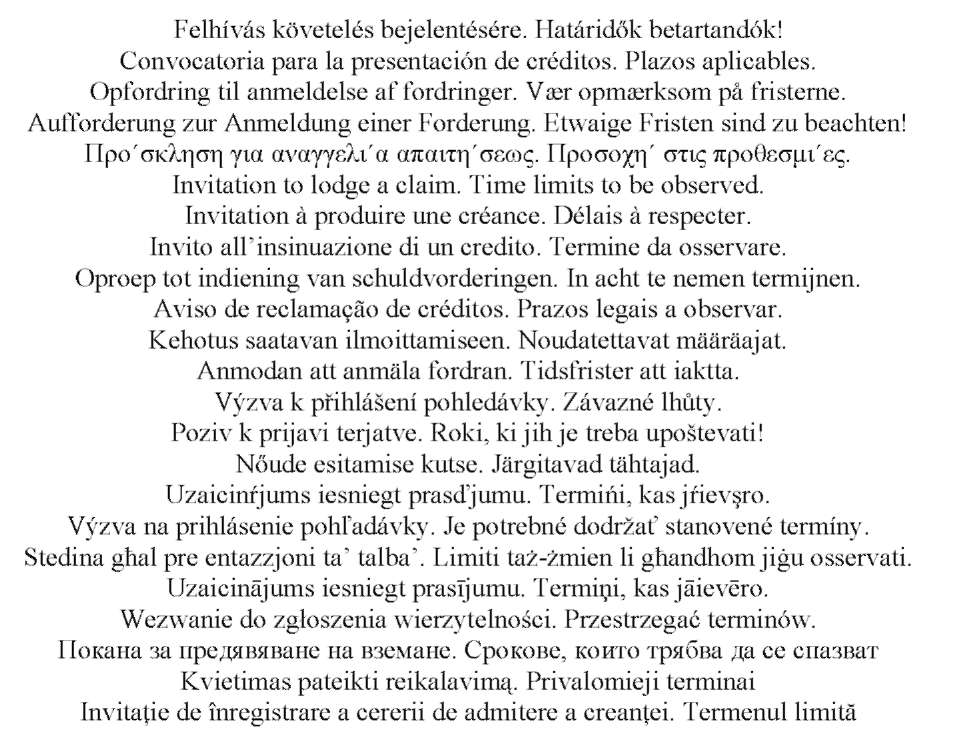
| 1. Court conducting the liquidation proceedings: |
| 2. Number of Court Decision opening the liquidation proceedings: |
| 3. Date of the Court Decision opening the liquidation proceedings: |
| 4. Debtor's name, registered office and address: |
| 5. Type of proceedings: main proceedings / territorial proceedings |
| 6. Liquidator's name, registered office and address: |
| 7. Date of the publication of the Court Decision opening the liquidation proceedings in the |
| official journal "Cégközlöny": |
| 8. Number of the fee cover account of the Finance Office under the Court conducting the |
| liquidation proceedings: |
I. The Court under point 1 opened liquidation proceedings against the Debtor under point 4 in its Decision passed on the date set out in point 3 under case number referred to in point 2. These liquidation proceedings are proceedings within the meening of Council Regulation (EC) 1346/2000 (point 5). The date under point 7 is the date of opening the insolvency proceedings (Article 2 f) of Council Regulation (EC) 1346/2000). In its decision the Court appointed the Liquidator under point 6. Starting from the date set out in point 7, any legal declaration concerning the Debtor's property shall only be made by the Liquidator.
The duty to provide information is provided for in Article 40 of Council Regulation (EC) 1346/2000 according to which the known Creditors who have their habitual residences, domiciles or registered offices in another Member State than where the insolvency proceedings are instituted shall be informed about the opening of the insolvency proceedings.
Article 39 of Council Regulation (EC) 1346/2000 prescribes that any Creditor who has his habitual residence, domicile or registered office in a Member State other than the State of the opening of proceedings, including the tax authorities and social security authorities of Member States, shall have the right to lodge claims in the insolvency proceedings in writing.
II.Time limit of lodging Creditor's claims
Pursuant to Section 28 (1) of Act XLIX of 1991 on Bankruptcy Proceedings and Liquidation Proceedings (hereinafter the Bankruptcy Act) the Court ordered that the Decision be published in the official journal Cégközlöny. The Court Decision was published on the date set out in point 7. Creditors shall lodge their claims to the Liquidator (point 6) in writing within 40 days of this date (Section (2) f) of Bankruptcy Act). The document on lodging the claim shall be posted as a recommended mail or a registered mail with acknowledgement of receipt on the last day of the term the latest.
Creditors' claims, incurred during the liquidation proceedings and not considered as liquidation expenses shall be lodged to the liquidator within forty days following the date when the claim falls due, provided that the final liquidation balance sheet has not yet been submitted.
The obligation to lodge a claim shall also apply to Creditors with security in rem.
According to Section 36 (1) of the Bankruptcy Act, in liquidation proceedings only such claims can be set off which have been registered by the Liquidator as recognized claims and have not been assigned subsequent to the time of the opening of liquidation proceedings, or, if the claim has arised at a later date, subsequent to its occurrence. The senior executive, senior employee of the business association in debt or their close relative or partner, the business association under the Debtor's controlling influence and the member of the business association in debt, having controlling influence in that business association in the case of a one-man company: the member, in the case of a Hungarian branch of a company established abroad: the company established abroad) may not set off its claim against the Debtor.
III.Legal consequences of missing the time limit for lodging Creditor's claims
Claims against the Debtor that were lodged over 40 days but within 180 days of publication of the liquidation shall be registered by the Liquidator, but such claims of the Creditor shall only be met if, except in the case of a composition agreement, financial cover is still available after settling any claims lodged on time (debts listed in Section 57 (1) of Bankruptcy Act). Failing to meet the 180-day time limit of publication in "Cégközlöny" shall entail forfeiture of the right to lodge claims (Sections 37 (1)-(3) of Bankruptcy Act).
IV.Form and content of lodging Creditor's claims
The Creditor shall submit the document on lodging his claim with the heading "LODGEMENT OF CLAIM" in 2 copies in the Hungarian language or in the official language or one of the official languages of the State of his own habitual residence, domicile or registered office; in the latter case he will be required to provide an official translation in Hungarian language. The document shall in every case bear the Hungarian language heading "KÖVETELÉSBEJELENTÉS" (i.e. "LODGEMENT OF CLAIM") (Article 42 (2) of Council Regulation (EC) 1346/2000).
In the document on lodging a claim the Creditor shall indicate the nature of the claim, the date on which it arose and its amount, as well as whether he alleges preference in respect of his claim and whether his claim is secured by any lien, another security in rem or a reservation of title, and what assets are covered by the lien, the other security in rem or the title reserved. The Creditor shall attach the copy of the documents that underlie the claim to the document on lodging his claim
(Article 41 of Council Regulation (EC) 1346/2000).
The Creditor shall specify the amount of his claim in Hungarian Forint (HUF) as well, at the exchange rate quoted by the National Bank of Hungary applicable at the time of publication in the official journal Cégközlöny.
Pursuant to Section 36 (2) of the Bankruptcy Act, in the case of a close-out netting agreement concluded prior to the time of publication in Cégközlöny, the Creditor shall notify the Liquidator of the net claim and the Liquidator shall enforce the net claim. When calculating the amount of net claim under a close-out netting provision, the principal transaction date shall precede the deadline specified by the parties to the agreement, but shall in all cases be pursuant to specific other legislation for the filing of Creditors' claims.
Another condition of registering the Creditor's claim is that the Creditor - apart from lodging his claim to the Liquidator - shall transfer 1% of the principal claim amount to be received from the Debtor but HUF 5 000 at least and HUF 200 000 at most to the fee cover account (point 8) of the
Finance Office under the Court ordering the liquidation proceedings (point 1), indicating the Debtor (point 4) and the case number of the Court Decision ordering the liquidation proceedings (point 2) and shall certify such to the Liquidator. If the liquidation proceedings were directly preceded by bankruptcy proceedings and the Creditor has lodged his claim there and has paid the fee for registration, he shall not need to lodge his claim again in the liquidation proceedings but shall pay the difference in fees upon the Liquidator's request.
If the Creditor fails to transfer this amount to the above account of the Finance Office and fails to certify such to the Liquidator, the Liquidator shall not register him as a Creditor. The obligation to pay the registration fee does not apply to Creditors whose claim is related to liquidation expenses, or alimony and life-annuity payments, compensation benefits, income supplement to miners which are payable by the business association, furthermore, monetary aid granted to members of agricultural cooperatives in lieu of household land or produce, for which the beneficiary is entitled for his/her lifetime under Section 57 (2) of the Bankruptcy Act (Section 46 (7) of Bankruptcy Act).
V. Registration of the Creditor's lodged claim
Pursuant to Section 46 (6) of the Bankruptcy Act, the Liquidator shall review the claims lodged by the due time within 45 days of the deadline for lodging such and shall consult with the parties concerned. If the Liquidator has concerns about the Creditor's claim with reference to either its legal basis or the amount, he shall notify the Creditor accordingly. If the Creditor does not agree with the Liquidator's notification and the consultation between the Liquidator and the Creditor brings no result, the Liquidator shall forward the claims deemed disputable to the Court ordering liquidation for judgement within 15 days. If the Creditor disagrees with the classification of his claim by the Liquidator, he may - according to Section 51 (1) of the Bankruptcy Act - file a complaint within 8 days after having become aware of it at the Court which has ordered liquidation (point 1). The Liquidator may not dispute the creditor's claim if the claim is based on the debtor's debts drawn upin an authentic instrument, unless the debts have been full or partially settled.
The Creditor may, according to Section 107 of Act III of 1952 on the Code of Civil Procedure, submit an application for certification to the Court which has ordered the liquidation proceedings within 15 days of the last day of the missed deadline. However, if the party or his representative only became aware of the failure later or if the obstacle was only prevented later, the deadline of the application for certification shall commence by the time of having become aware of the failure or the prevention of obstacles, respectively. No application for certification shall be submitted after 3 months of the failure. The application for certification shall specify the reason for failure and the circumstances that support the probability of being innocent in failure. The failed action (lodgement of Creditor's claim) shall be taken simultaneous with submitting the application for certification
VI. Chapter IV of the of the Bankruptcy Act provides for specific rules applicable to undertakings declared by a Government Decree to have high strategic priority
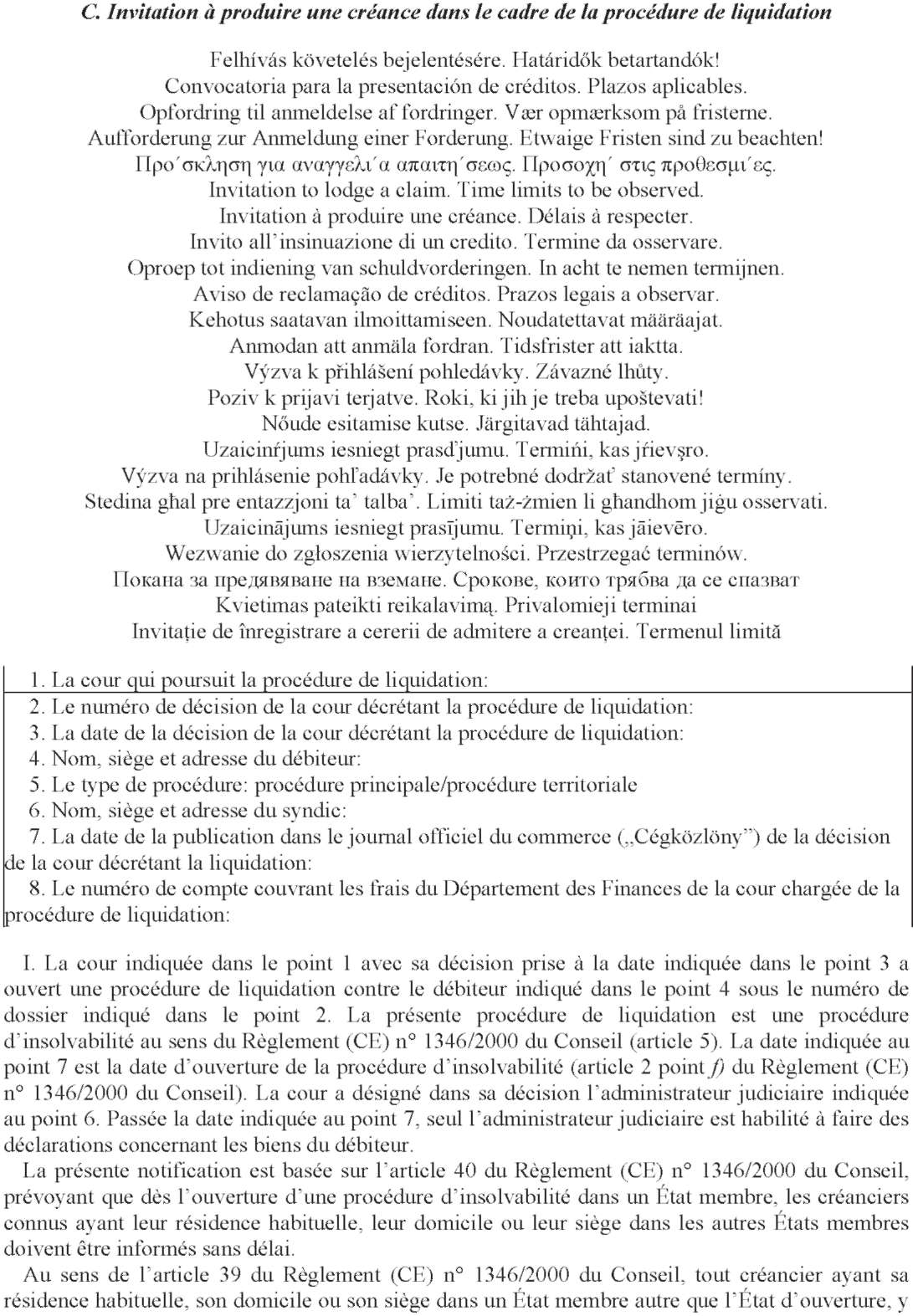

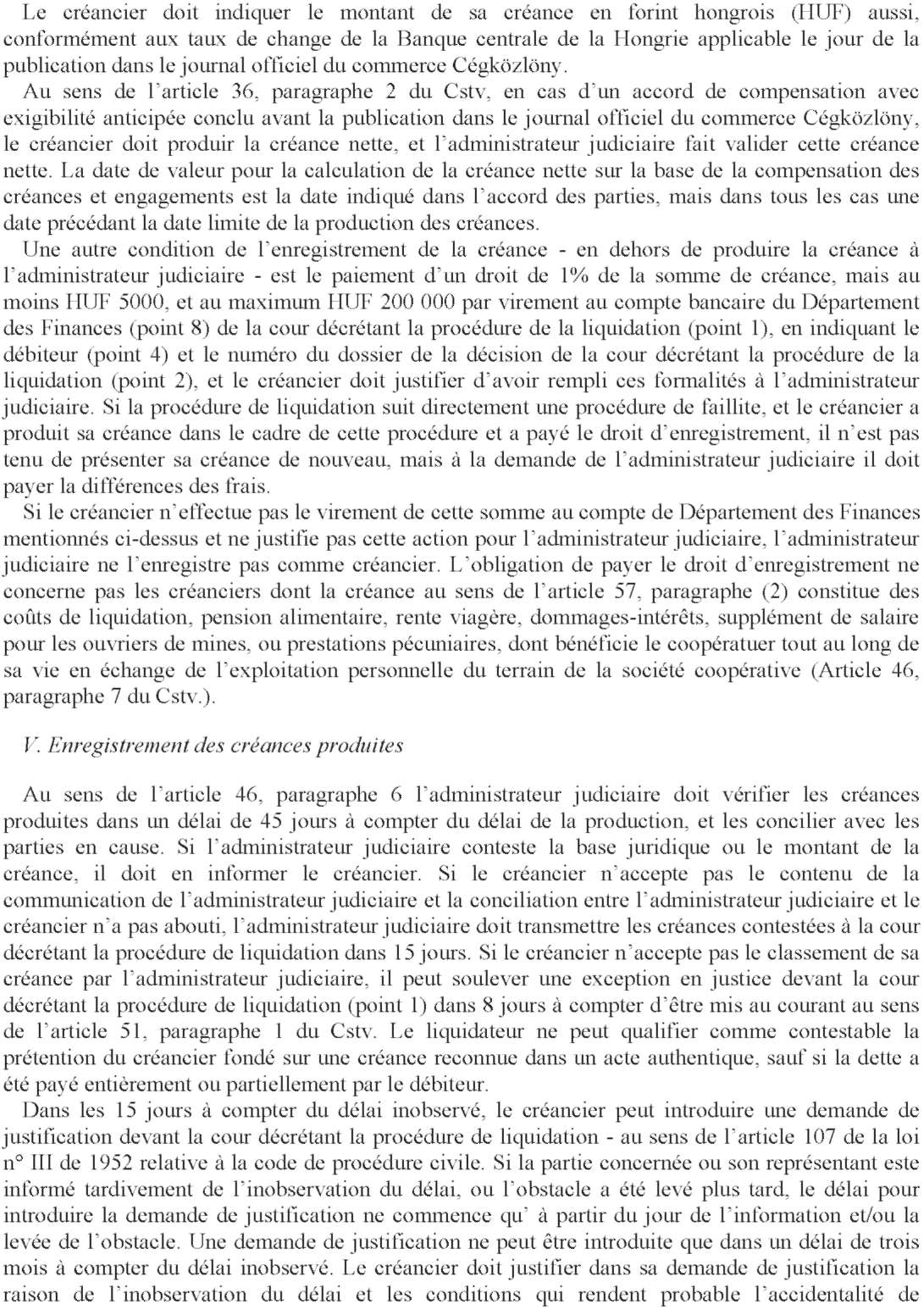

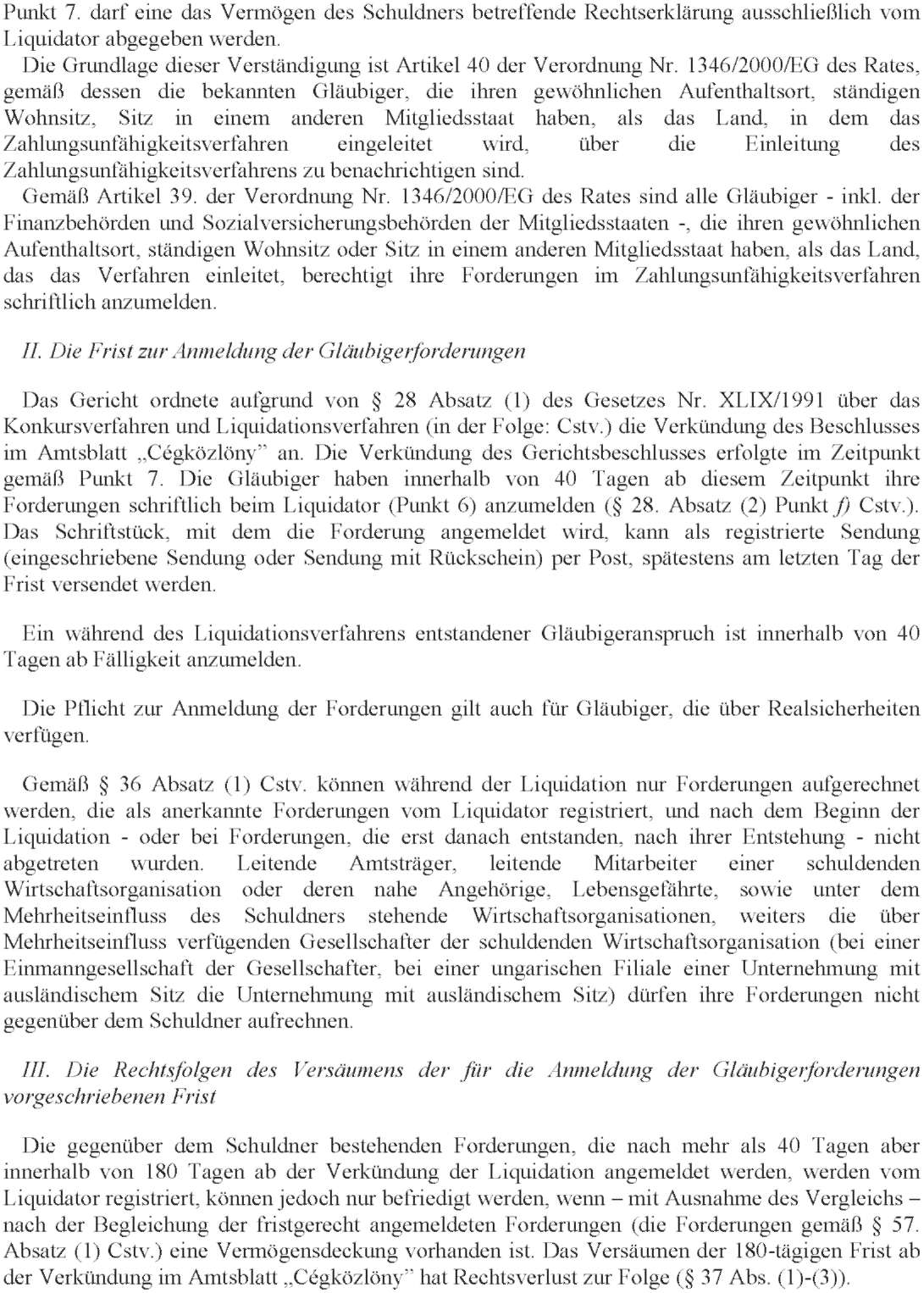
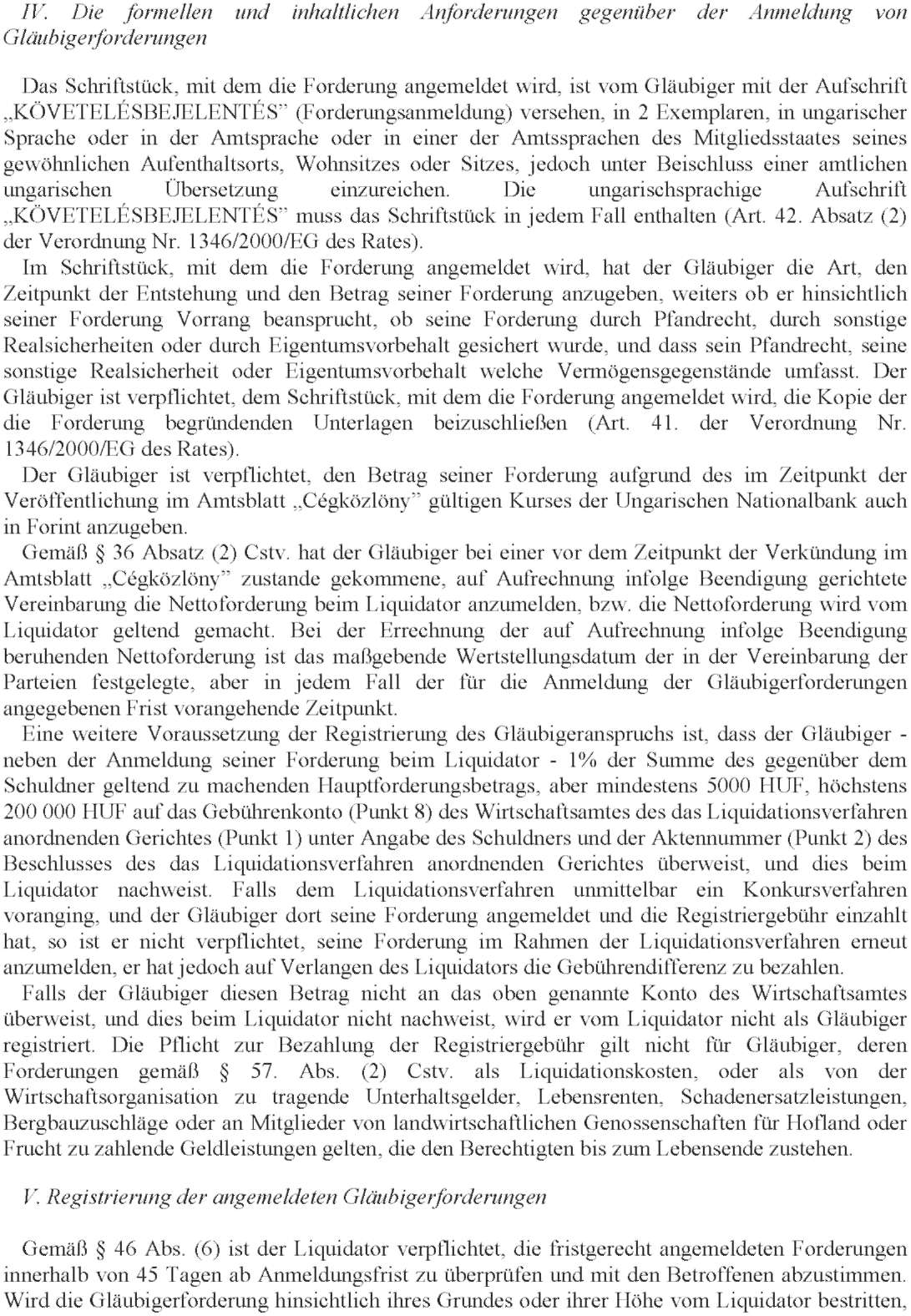
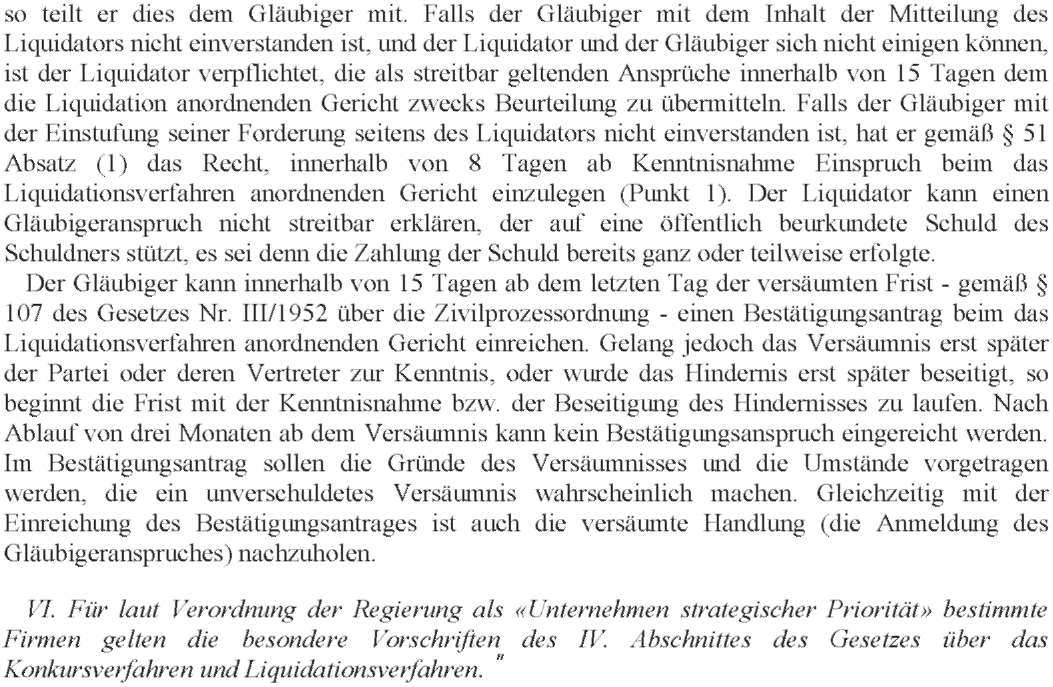
Lábjegyzetek:
[1] 27/2021. (I. 29.) Korm. rendelet a veszélyhelyzet kihirdetéséről és a veszélyhelyzeti intézkedések hatálybalépéséről
[2] 40/2020. (III. 11.) Korm. rendelet veszélyhelyzet kihirdetéséről
[3] Hatályon kívül helyezte e rendelet 2. § (2) bekezdése. Hatálytalan 2009.09.02.
[4] Megállapította a 14/2012. (III. 1.) KIM rendelet 1. § (1) bekezdése. Hatályos 2012.03.02.
[5] Megállapította a 14/2012. (III. 1.) KIM rendelet 1. § (2) bekezdése. Hatályos 2012.03.02.


